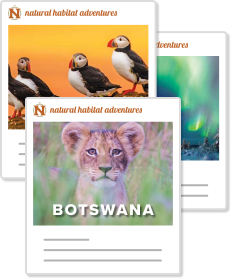2026 Itinerary

Arrive in Chengdu, the vibrant capital of Sichuan province. Over a group lunch, get to know your Expedition Leader and our local Chinese naturalist guide, and enjoy your introduction to the renowned cuisine of Sichuan that will be a highlight of our travels together—in 2011, Chengdu was recognized by UNESCO as a City of Gastronomy. Chengdu is also famed for its association with the giant pandas of Sichuan and is home to the Chengdu Research Base of Giant Panda Breeding. Learn more about the city as we discover some of its highlights with our Expedition Leader this afternoon. Founded in 4th century BC, Chengdu is unique as the only major Chinese settlement that has maintained its name unchanged throughout the imperial, republican and communist eras for more than 2,000 years. Chengdu is an important center for higher education in China and one of the world’s top 25 cities for scientific research. We take a walk through serene Bamboo Park on the Jin River, a leafy enclave where locals enjoy strolling, playing mahjong and practicing tai chi. After time to relax at our luxury hotel in the city, gather for a welcome dinner and an orientation to all the nature adventures that lie ahead.
Day 2: Chengdu / Qing Xi / Wild Panda Nature Reserve
The bustle of the city is soon behind us as we depart this morning on a drive north into the Minshan Mountains, an enclave of lush peaks and deep gorges that protects an abundance of rare and endangered Chinese wildlife. En route, we stop in the Muslim village of Qing Xi, with time to wander its narrow lanes enjoying scenes of relaxed street life amid 300-year-old wooden buildings that date to the Qing dynasty. It's a peaceful setting, with a stream coursing through the center of the village. Just beyond the small town lies a secret slice of Chinese wilderness, a chain of nature reserves little known to outsiders and visited by a mere handful of Westerners. Our destination is a national sanctuary that harbors a vital population of wild pandas. We don’t choose to name it, as it is virtually un discovered by tourists, and we are likely to be the only visitors there. As we follow a rushing river up the narrow valley to reach the reserve, keep an eye out for nocturnal wildlife starting to emerge as dusk descends. Eventually, we reach our hotel, tucked away in the forest along the river, in a setting where our nearest neighbors are mostly wild animals that thrive in these remote protected environs.
Day 3: Exploring the Wild Panda Nature Reserve
Our focus for two exciting days is a remote 100,000-acre sanctuary encompassing a densely forested ecosystem that is among the most diverse and intact in Asia. This national reserve, rated Grade I by WWF as a global biodiversity hotspot, is home to healthy populations of some of the world’s most endangered and vulnerable wildlife, including at least 60 giant pandas. Among its 430 different mammal species, the reserve also harbors more than 1,200 takin — a large, shaggy relative of wild sheep and goats — as well as more than 2,400 different kinds of plants. Look for wildlife on morning and evening excursions, stopping to enjoy stunning vistas of waterfalls, boulder-strewn gorges and mist-shrouded limestone peaks. This is prime panda habitat, and although sightings of this famously elusive animal are extremely rare, our exclusive permits allow us into remote areas of the reserve where they freely live and breed, affording us the best possible opportunity to spot signs of them in the wild. Even if we are highly unlikely to spy them in the heavy bamboo understory, just knowing that we’re in their midst is exhilarating.
Day 4: Wild Panda Nature Reserve / Pingwu
Spend another day searching for wildlife as we explore more of the reserve’s lush recesses. Within the sanctuary, we look for Tibetan and rhesus macaques, golden and Sichuan takin, musk deer, muntjac, serow, wild boar and blue sheep. More rarely, we may also see endangered moon bears and red pandas. Birding is superb, with more than 150 species in the reserve—the elegant golden pheasant is a prize. We can often observe all of these from the many remote roads and trails we explore, although dense vegetation and weather may affect our sightings. Late this afternoon, we depart the reserve and follow the scenic Fujiang River through the Min Mountains, returning to Qing Xi where we stop for an authentic local hot pot dinner. Afterward, we drive a short distance to Pingwu in far northwest Sichuan, our destination for the next two nights.
Day 5: Golden Monkey Nature Reserve
Rise early this morning to follow the scenic Fuijang River into the forested nature reserve that is home to golden snub-nosed monkeys living in the shadow of Sichuan's tallest mountain. We walk uphill for about 30 minutes on a trail leading into the reserve where the monkeys reside, with rest stops en route. The reserve covers 62 square miles of wild terrain filled with alpine forest, waterfalls, lakes, colorful karst formations, glacial rivers and an abundance of animal life. We expect excellent sightings of endangered golden monkeys, which have been habituated to humans and are unfazed by our presence. The monkeys live in highly social bands, and their interactions delight us. Covered with a mantle of long, shaggy fur, they are hardy creatures, tolerating winter snow and colder temperatures better than any other non-human primate. On our return journey to Pingwu, we drive through territory home to Baima Tibetans, the descendants of Tibetan soldiers sent here more than 1,300 years ago to conquer the frontier. Keep an eye out for hats sporting white rooster feathers worn only by this group of Tibetan women.
Day 6: Scenic Drive / Dujiangyan Panda Valley
A spectacular mountain drive is in store as we make the journey south to Dujiangyan. Winding through this mountainous region, we pause periodically along our route to admire dramatic landscapes, rural villages and Buddhist temples. Along the way, we pass through Mianyang, known as Fujun in ancient times, with a 2,200-year history that spans the Qin and Han dynasties.
This afternoon, visit Dujiangyan Panda Valley, a new facility that is both a panda research and breeding base and a center for conservation education. This quiet research base is landscaped with beautiful flowers, and in natural environs, pandas are gradually habituated and returned to the wild. Reintroduction training experts from around the world gather here for collaborative research. We may see pandas in transitional concrete block “dens” that are learning to live on their own in the natural surroundings. We often see many red pandas here as well.
Day 7: Gengda Wolong Panda Base / Rilong
Setting out from Dujiangyan, we head for the newly rebuilt Gengda Wolong Panda Center in the Wolong Nature Reserve, a base that integrates scientific research, captive breeding and reintroduction of pandas into the wild. More than 30 pandas reside at the center, which includes a 680-acre bamboo forest. Get close-up photos of giant pandas in this natural habitat that features a striking mountain backdrop. Then, traveling west, we continue to Rilong, a Tibetan village known famously as a base camp for climbing 20,505-foot Mount Siguniang. Translating to Four Sisters Mountain, this imposing massif encompasses four separate peaks and is often referred to as the “Chinese Alps.” In Rilong, we are immersed in Tibetan culture, with traditional architecture on display and yak butter tea for sale by local vendors. This high-altitude village, 10,000 feet above sea level, is the center of the Jiarong Tibetan culture, found only in this region of Sichuan province. The rural Jiarong people are known for their intricately embroidered costumes and agricultural lifestyle.
Day 8: Rilong—Siguniangshan National Park
Early risers may catch the sunrise behind the peaks in Rilong, a vista renowned for its singular beauty. We spend the day exploring the dramatic scenery of nearby Siguniangshan National Park. Entering the 25-mile-long Shuangqiao Valley, snow-capped peaks rise in every direction, with Four Sisters Mountain towering above. The valley floor is 10,000 feet above sea level, and the highest mountains nearly double that. Explore the colorful geological features and mirror-like lakes of this subalpine terrain, following boardwalk trails that weave among occasional pagodas and prayer flags. This high-altitude forest is also native habitat for the endangered red panda. Deeper into the valley, we reach the Ginsenguo flatland, with a viewing deck overlooking highland swamps and snowy peaks, and Jiujia Lake, which is actually a group of four seasonal lakes and nine perennial ones—the legendary bathing pools for the “four sisters.” After a full day of exploration in the park, we travel back down the valley to spend a second night in Rilong.
Day 9: Baoxing Valley / Labahe Nature Reserve
Depart this morning for Labahe Nature Reserve located southwest of Chengdu in the Hengduan Mountains. En route, we travel through another Jiarong Tibetan region, the Baoxing Valley separating the plains of Sichuan from the Tibetan Plateau. Here we visit Dengchigou Catholic Church where Father Pere Amand David stayed in the mid-19th century, introducing the giant panda to the Western world for the first time. The priest, who was also a natural historian and researcher with the National Museum of France, is credited with finding 68 new bird species, more than 100 insect species, and many mammal species including golden monkeys and Milu deer in addition to giant pandas, which he revealed to the wider world in 1869.
Once we reach the Labahe Reserve, we check in to our hotel, then head out to start exploring. Labahe is one of China’s top spots for finding the elusive and endearing red panda, and while sightings are never guaranteed, we often spy them. As the day draws to a close, we may see water deer coming down to a salt lick just outside our hotel.
Day 10: Labahe Nature Reserve
A full day is dedicated to searching for wildlife, especially red pandas, in the Labahe reserve. Although giant pandas also live here, we are less likely to see them. Comprised of mixed forests and pockets of dense bamboo, the reserve’s diverse vegetation and altitude create ideal habitat for the red panda, which is adapted to environments above 7,000 feet. A wide variety of other mammals and birds thrives here, too, and we look for Tibetan macaque, Chinese leopard cat, hog badger, serow, sambar deer, golden takin, and red and white giant flying squirrels. Notable birds include the golden-breasted fulvetta, Lady Amherst’s pheasant, crimson-breasted woodpecker and three-toed parrotbill. In our private vehicle, we have the freedom to explore different parts of the reserve, including opportunities for stunning landscape photography from higher mountain locations.
Day 11: Labahe / Bifengxia Panda Base / Chengdu
Early this morning, we depart for Bifengixa Panda Base, a branch of the China Conservation and Research Center for the Giant Panda opened in 2003. Previously, as the program at the main Wolong Panda Center continued to grow, it becoming crowded, and the threat of an outbreak of disease or infection was of great concern. If an epidemic were to occur among the captive giant pandas at Wolong, it could destroy the entire population. Splitting it into two separate populations, with a second panda group located at Bifengxia, was planned to prevent this from occurring. We’ll see plenty of pandas roaming within large enclosures filled with lush vegetation, including their favored food, bamboo. Afterward, we visit scenic Bifengixa Gorge and have lunch before continuing to our hotel at Tianfu Airport for convenient departures tomorrow. This evening, we celebrate our adventures at a farewell dinner.
Day 12: Chengdu / Depart
After breakfast at our hotel, transfer to the nearby airport terminal to meet departing flights.



























